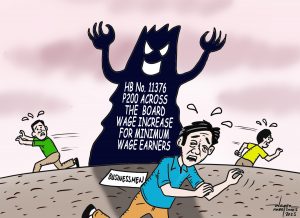President Ferdinand “Bongbong” Marcos, Jr. who was in Zamboanga City early this week, let out his thoughts that rice at P20 per kilo is still possible.
We are just wondering if he has some trusted advisers who are bold enough to tell him that he must now stop harping on that promise of his during the campaign for the 2022 national elections. We are also tinkering with the idea that if he has any such advisers the President does not care to listen at all.
Imagine, the President is still hoping for the return of a P20 per kilo rice after the staple has gone to a high of as much as P55 to P60 a kilo. His insistence that the cost could still go back to P20 a kilo is a perpetuation of one nebulous dream that will remain in the emptiness of the mysterious space above the hungry Filipinos.
Or, is the President thinking that he is on board a time machine that is about to take him back to the 70s when rice was roughly between P7 to P10 per kilo? That was the time of his late father when the country was still the leading rice producer in the whole of Asia and the countries where we are now importing rice were sending their technicians to the Philippines to study how we did it.
But sadly for BBM times have changed. The once huge tracts of land devoted to rice farming are now either converted into residential subdivisions or leased on long-term basis for corporate farming planting bananas or pineapple or papaya.
And even in attitude, heads of farming families whose interest were once devoted to farming are now aging and they are giving in to the wishes of their children to veer away from farming and instead work in large corporations based in the cities.
On the other hand, other than sharing his dream, of a P20 per kilo rice, the President expanded the buying cost of wet and dried palay. He wanted the acquisition cost of wet palay upped from P16 per kilo to P19; and for dried palay from P19 a kilo to P24.
Assuming that this will be complied, still there is no certainty that the retail prices in the markets will go down to benefit the majority of the common man consumers. In fact the mandated hike in farm gate prices of palay will be another opportunity for the greedy and shrewd bulk palay buyers to manipulate their disposal costs to the retailers. They can always claim that they have to recover the additional capital poured in by them as a consequence of the mandated farm gate prices.
Of course it is a given that the mandated increase in the buying cost of palay will benefit the farmers somehow. But how much percent is the number of farmers to that of the entire number of consumers all over the country?
As we love to say, real improvement in the status of the people’s lives should always be equated to the number of beneficiaries of certain programs or policies of government to that of the number of those who would likely suffer in the process vi-a-vis the measures taken to address the would-be sufferers’ plight.
*************************
On the same Zamboanga City visit however, the President mentioned a possible solution to the frequent flooding in several places in the country including the urban centers of cities. He talked of his administration’s plan to build water impounding dams in areas known to be continuously submerged in water every time there are prolonged strong rains. This is one project that we had been espousing for long to be undertaken in Davao City.
We have no doubt that most Davaoenos are aware which areas in the city are likely to be flooded when heavy rains fall. We have the lowlands in the Bunawan-Lasang areas in the city’s north sector; we have the communities along the Davao River and Matina Pangi River and the La Verna stretch of the C.P. Garcia diversion highway; and of course the large flat in the Toril district.
An impounding dam in any of these areas could definitely mitigate flooding. But so far, we know of only one impounding dam project being under feasibility study with the help of the Japan International Cooperation Agency (JICA). It is the one proposed to be constructed in the lowlands of Luman, New Carmen and Waan within the vicinity of the Davao River.
But even at this early stage of its feasibility study, there is already strong opposition from residents in the areas concerned and from environmentalist groups. So, the possibility is that such an impounding dam will again fly to the nebula of unfulfilled dreams for a city free of devastating floods.
Meanwhile, the number of traffic bottlenecks in Davao City may soon be reduced. Thanks to the ongoing construction of two overpasses. One is that in Ulas-Davao-Bukidnon junction and the other is the one at the C.P. Garcia-Crossing Maa road. Once completed congestions will be reduced substantially in those junctions where normally these days vehicular traffic is always in bedlams. The problem that may likely to remain is the menace that is brought about by reckless and undisciplined drivers and uncaring, irresponsible vehicle owners and operators.




